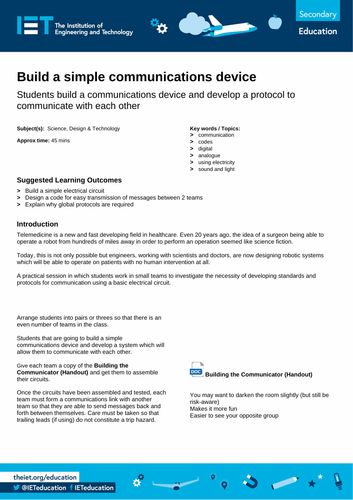




Students build a communications device and develop a protocol to communicate with each other
This is an engaging and practical activity in which students will work in small teams to investigate the necessity of developing standards and protocols for communication using a basic electrical circuit.
Their objective is to build a basic communication device and establish communication between teams. Each team should receive a copy of the ‘Building the Communicator’ handout and proceed to assemble their circuits.
This activity is a great way to introduce students to the history and practical use of telecommunication while also engaging their creativity and problem-solving skills.
How long will this activity take?
This activity will take approximately 45 minutes to complete.
Tools/resources required
Per team:
One non-latching push to make switch
Connecting leads
One light bulb (3V approx) and holder
One 3V power supply (best to use cells so that bulbs do not blow)
Supply of crocodile clips
The engineering context
Telemedicine engineers are professionals who specialise in designing, developing, and implementing technological solutions for remote medical care. They utilise their expertise in engineering, software development, and medical equipment to create systems that enable patients to receive medical care remotely. Telemedicine engineers also work closely with healthcare providers to understand their needs and develop solutions that address their challenges.
Telemedicine engineers play a critical role in expanding access to healthcare for patients in remote areas. They contribute to the development of cutting-edge technology that allows medical practitioners to deliver high-quality care to patients from a distance.
Suggested learning outcomes
By the end of this activity students will be able to build a simple electrical circuit, design a code for easy transmission of messages between two teams and explain why global protocols are required.
All activity sheets and supporting resources are free to download, and all the documents are fully editable, so you can tailor them to your students’ and your schools’ needs.
The activity sheet includes teacher notes, guidance, useful web links, and links (where appropriate) to the national curriculum in each of the four devolved UK nations; England, Northern Ireland, Scotland and Wales.
Please share your classroom learning highlights with us @IETeducation
Something went wrong, please try again later.
This resource hasn't been reviewed yet
To ensure quality for our reviews, only customers who have downloaded this resource can review it
Report this resourceto let us know if it violates our terms and conditions.
Our customer service team will review your report and will be in touch.